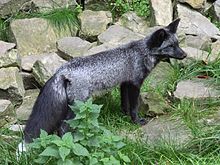Domesticated silver fox
| Russian domesticated red fox | |
|---|---|
 |
|
|
Domesticated
|
|
| Scientific classification | |
| Kingdom: | Animalia |
| Phylum: | Chordata |
| Class: | Mammalia |
| Order: | Carnivora |
| Family: | Canidae |
| Genus: | Vulpes |
| Species: | V. vulpes |
| Binomial name | |
|
Vulpes vulpes |
|
The Russian domesticated red fox is a domesticated form of the red fox (Vulpes vulpes). As a result of selective breeding, the new foxes became tamer and more dog-like.
The result of over 50 years of experiments in the Soviet Union and Russia, the breeding project was set up in 1959 by Soviet scientist Dmitri Belyaev. It continues today at the Institute of Cytology and Genetics at Novosibirsk, under the supervision of Lyudmila Trut.
The experiment was initiated by scientists who were interested in the topic of domestication and the process by which wolves became domesticated dogs. They saw some retention of juvenile traits by adult dogs, both morphological ones, such as skulls that were unusually broad for their length, and behavioral ones, such as whining, barking, and submission.
In a time when centralized political control in the fields of genetics and agriculture promoted Lysenkoism as an official state doctrine, Belyaev's commitment to classical genetics had cost him his job as head of the Department of Fur Animal Breeding at the Central Research Laboratory of Fur Breeding in Moscow in 1948. During the 1950s, he continued to conduct genetic research under the guise of studying animal physiology.
Belyaev believed that the key factor selected for in the domestication of dogs was not size or reproduction, but behavior: specifically, tameability. Since behavior is rooted in biology, selecting for tameness and against aggression means selecting for physiological changes in the systems that govern the body's hormones and neurochemicals. Belyaev decided to test his theory by domesticating foxes, in particular, the silver fox, a dark color form of the red fox. He placed a population of them under strong selection pressure for inherent tameness. According to Trut:
...
Wikipedia
